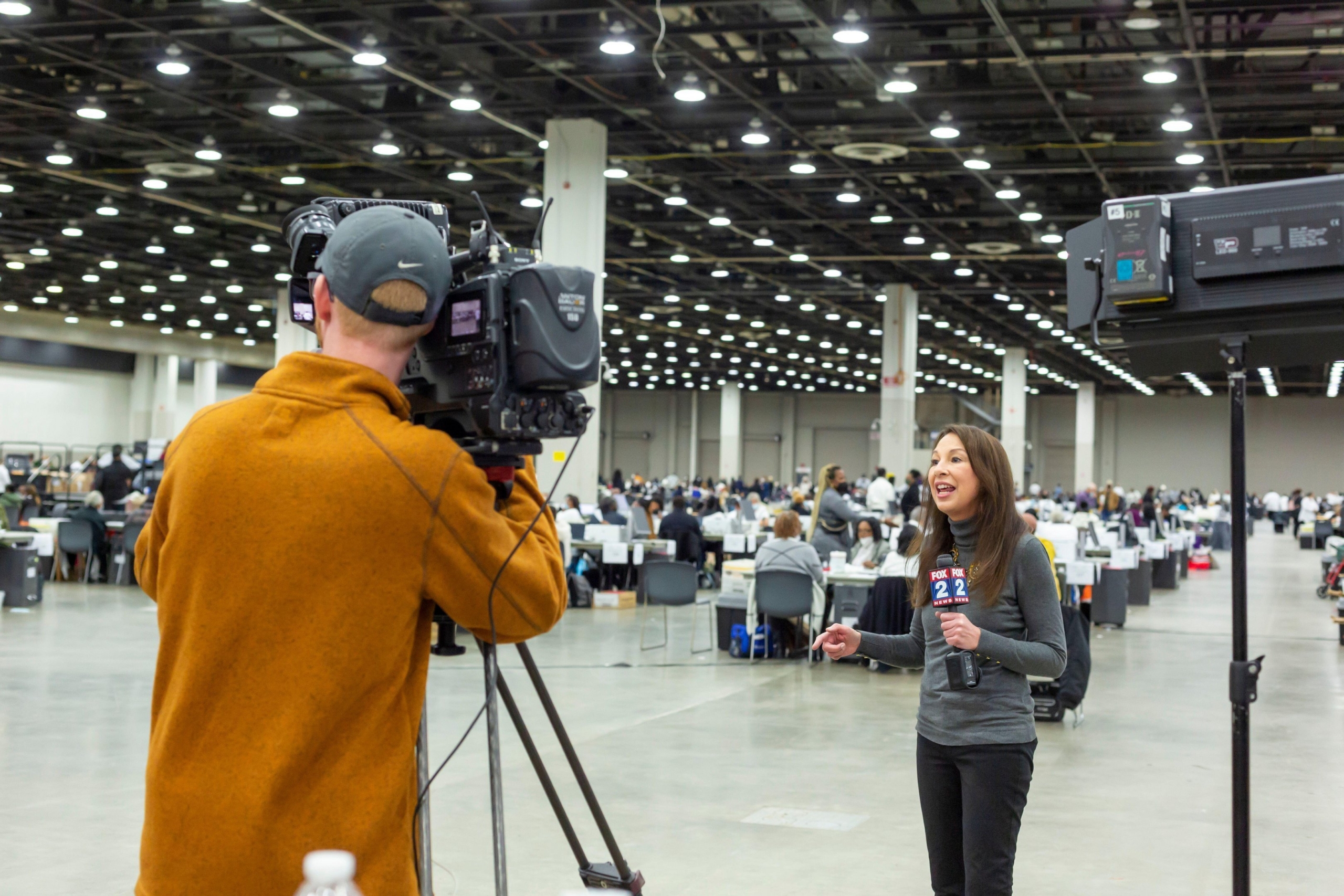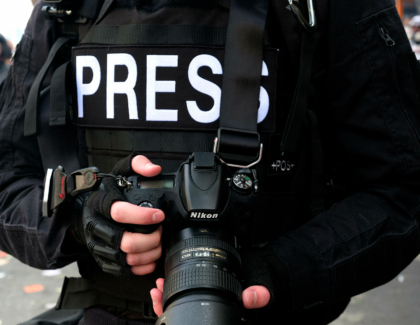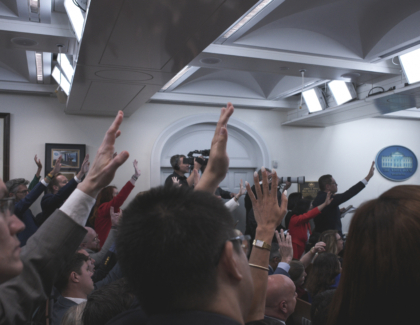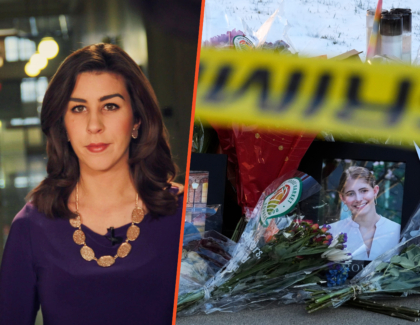Sign up for the daily CJR newsletter.
In recent years, election workers across the US have faced increased danger. The uptick in threats largely followed Donald Trump’s false claims about the 2020 election; in 2021, the Justice Department established a task force in response. This spring, news outlets reported that some twenty people had been charged with threatening election officials in 2020 and 2022—a small fraction of the thousands of threats reported.
Tina Barton, a longtime government employee, experienced death threats over her work as a clerk in Michigan during the 2020 presidential election. Now she works with other election workers to help plan for such incidents in her capacity as an expert with the Committee for Safe and Secure Elections, which was founded in 2021 as a bipartisan group. The committee aids election offices in developing protocols for responding to security challenges that arise, including doxxing (or the publication of people’s personal details online), swatting (or the placing of fake emergency calls to a person’s address), and in-person violence and harassment.
Barton is working in an intense environment ahead of the upcoming presidential election. During the campaign, Trump and his allies have spread false claims that have had violent or otherwise disruptive consequences for people’s lives; false claims of electoral dirty tricks are circulating, and a recent poll conducted by NPR, PBS, and Marist found that most Americans are concerned about fraud. Last week, I spoke with Barton about the types of threats election workers now face, the role the media plays in intensifying them, and how journalists can responsibly cover claims of electoral fraud. Our conversation has been edited for length and clarity.
FM: What are some of the threats that election workers are facing?
TB: Some of the concerns that we’re looking at involve some type of a disturbance in a polling location. That might be two people from opposite sides of the political spectrum getting into some sort of conflict. We also consider the possibility of protests or demonstrations that could happen outside, particularly in open-carry states, which raises additional safety concerns. We look at swatting incidents, where false reports trigger armed responses. Doxxing is another issue we discuss, which can severely impact election officials and law enforcement; what to do if you have been doxxed is crucial information. We’re also aware of potential threats from fentanyl and other unknown substances being sent in the mail. We’ve seen a concerning rise in these incidents—close to twenty-six different instances in the last year.
How are election officials preparing for potential threats during the election?
Election officials are actively crafting scenarios that address specific threats they might face. Our preparations include assessing the physical security of polling locations and operational responses to various situations; for instance, if there were to be a protest, especially in a battleground state, we consider how that might affect ballot counting and what security measures would need to be in place. Each community’s past experiences inform these preparations, so we can tailor our strategies to their specific needs and concerns.
What responsibility does the media have when reporting on election-related events?
The media plays a significant role in either mitigating or exacerbating tensions around elections. It’s crucial that journalists understand the potential impact of their reporting on public sentiment and behavior. When headlines or stories sensationalize events or misrepresent facts, they can incite violence or unrest. For example, if a headline reads, “Michigan’s second-largest city lost an entire tray of mail ballots,” it implies that the election clerk was careless when, in reality, the tray was unaccounted for by the United States Postal Service, not the clerk. Such sensationalized reporting can lead to public outrage and erode trust in election officials, making it critical for journalists to be precise in their wording and ensure that all aspects of a story are accurately represented. This means not only getting the facts right but also considering how headlines and stories can influence public perception and behavior.
In addition to sensationalizing or misrepresenting events like the case that you just mentioned, journalists have to field claims of electoral malfeasance, for example Trump’s stolen-election lies. How can journalists responsibly respond to this type of claim?
The media has a critical responsibility to verify, then report. It’s essential that the urgency to be first or to have the hottest story doesn’t overshadow the commitment to factual reporting. When something is reported inaccurately, it can lead to real-world consequences, including threats against individuals involved in the electoral process. If a claim sounds outrageous, it probably is. Journalists should take a moment to pause and verify before reporting. The key is to go to trusted sources for information; it’s vital to go straight to the election official or the secretary of state’s office, and consult their official websites to get accurate data. It might feel like an extra layer of effort, but at the end of the day, we all have to get this right—not just the election officials but the media as well. Ensuring that facts are verified before they hit the airwaves is essential in maintaining the integrity of the information shared with the public.
What would you advise journalists to keep in mind after voting actually starts, given the ubiquitous live coverage that seeks to track results?
One thing I hope that journalists will do is really push the message that election results are not official until they’ve been certified. From Election Day until certification, there’s a process that involves canvassing all the results, allowing for corrections of any human errors. It’s vital to stress that these are unofficial results, because sometimes networks will call a state for a candidate while voting is still happening. If I’m a voter watching the news and they announce that a state is already called for one candidate, I might think, Oh, my vote’s not even going to count. This kind of premature reporting not only misrepresents the voting process but can also inadvertently suppress turnout, so conveying this information accurately is essential.
Correct terminology is also crucial in this context. Take the example of ballot duplication versus ballot replication—different states use different terms, and misunderstanding these can lead to confusion. In Michigan, for instance, if a ballot is damaged, election officials can duplicate it with a bipartisan team ensuring accuracy. However, other states might refer to this process as replication or use entirely different terminology. This discrepancy can create misconceptions about the integrity of the election process. It’s essential for journalists to use precise language and convey accurate information to help inform the public and reduce potential misinformation.
Other notable stories:
- CNN’s Brian Stelter examined Trump’s repeated threats to strip major news networks—most recently CBS—of their broadcast licenses in response to coverage he doesn’t like. In reality, “national networks like CBS are not licensed, but local stations are,” Stelter writes. One legal expert said that the licensing renewal process “is so time consuming that no license renewal could be denied before the end of a hypothetical second Trump term,” but Stelter notes that there remains “a conceivable chilling effect. Trump’s threats have grown so insistent that some TV industry executives have speculated that they could be vulnerable to some sort of retaliation if Trump returns to power.” (For more on how Trump could weaponize the power of the government against the press, read Kyle Paoletta’s recent feature on the Espionage Act for CJR.)
- Last week, the editorial board of the LA Times issued a slate of endorsements for the 2024 election cycle, describing it as perhaps “the most consequential election in a generation”—but then declined to endorse any candidate for president. Semafor’s Max Tani now reports that the board was preparing to back Kamala Harris, only for the paper’s owner, the medical entrepreneur Patrick Soon-Shiong, to block it from doing so. The paper has not explained the decision and declined to comment to Tani. Ben Smith, Semafor’s editor, interpreted the move as being part of a “broader accommodation to Trump by elites.” The journalist David Boardman argued that Soon-Shiong’s motives matter, but that news organizations should not be in the business of endorsements.
- This week, two stories once again illustrated the complex relationship between the news business and AI companies (which Mathew Ingram wrote about in this newsletter earlier this year). On Monday, Rupert Murdoch’s News Corp sued Perplexity, an AI-powered search engine that summarizes content for users without their having to click through to third-party sources, alleging that it has stolen copyrighted News Corp content “on a massive scale.” Then, yesterday, OpenAI and Microsoft, its minority owner, announced that they are funding a ten-million-dollar collaboration and fellowship program to help local newsrooms harness AI, to be administered by the nonprofit Lenfest Institute.
- Yesterday, the Globe and Mail, a newspaper in Canada, identified senior officials who reportedly handed intelligence to the Washington Post relating to violence that agents of the Indian government are said to have perpetrated on Canadian soil. As Politico’s Ottawa Playbook newsletter notes, the story sparked an ethical debate: the New York Times’ Canadian bureau chief described the Globe and Mail’s decision to “out” another outlet’s sources as “disturbing & strange”; another journalist countered that the paper was really “outing a double standard” since the briefing of the Post was apparently authorized.
- And Ryan Gamboa, a reporter at KSHB-TV in Kansas City, was injured yesterday after he was struck by a bullet fragment while covering a campaign event for Lucas Kunce, the Democratic US Senate candidate in Missouri, at a shooting range. Kunce, who apparently fired the shot that precipitated Gamboa’s injury, administered first aid to Gamboa, whose arm was bleeding, and Gamboa was subsequently able to continue reporting. The Kansas City Star’s Dominick Williams has more details of the incident.
Has America ever needed a media defender more than now? Help us by joining CJR today.







